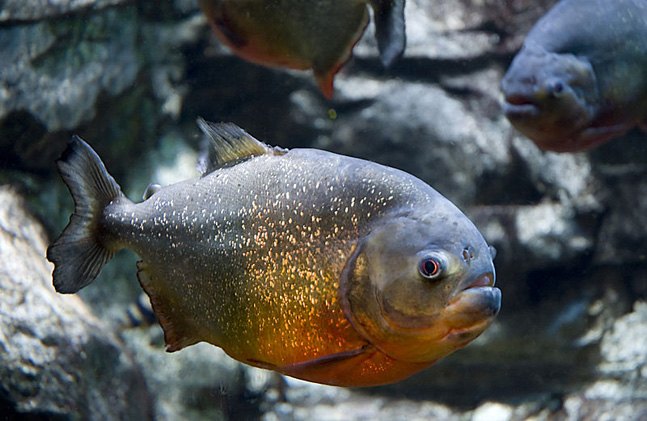
About Piranha
Group
Freshwater
Size
Medium to large
Temperament
Aggressive
Aquarium Size
Large (50+ gal)
Swimming Region
Middle
Fish Water Condition
Difficulty Of Care
Top Breed
10
Suitable Tank Mates
Tetras, Guppies, Other piranhas of the same species

Piranha General Description
Piranhas are a family of extremely aggressive freshwater fish made up of more than 30 sub-species. They are characterized by two rows of extremely sharp, triangular shaped teeth which are tightly packed in both jaws. Most species of piranha are fierce predators and some species like the Red Bellied Piranha are known to attack in schools and strip away the flesh from the bodies of large mammals within a matter of seconds.
It is important to remember that it is illegal in many parts of the world, including the United States, to buy, sell or raise most species of piranhas.
Piranhas are a family of extremely aggressive freshwater fish made up of more than 30 sub-species.
Origins
Piranhas originate from the rivers of South America.
Color
Piranhas are typically colored in shades of red, blue, green, brown, silver or black.
Maintenance and care

Although commonly thought of as a schooling species of fish, research has shown that piranhas only school as a means of protection from larger species of fish that prey on them. Piranhas appreciate aquariums with heavy plant growth and ample hiding spaces. Different species of piranha vary from 8-18 inches in length when fully grown and should be kept alone or in large groups of four or more in very large aquariums. When cramped for space, these fish can turn extremely jumpy and start attacking each other. While some aquarists are known to have successfully raised piranha with other larger species of fish and sometimes smaller species like tetras and guppies, it is never a foolproof strategy. While they can often be tolerant of extremely large or extremely small tank mates, they can also attack easily when feeling threatened or starved. Care should be taken when cleaning the aquarium as they can easily remove large chunks of flesh with a single bite.
Piranhas are heavy eaters and thus produce an extremely large amount of waste. For this reason it is important to ensure that the aquarium has adequate filtration and also that water changes are carried out every week.
Feeding
Most species are omnivores, but show a strong predilection towards meat. Piranhas thrive on live foods and it is virtually impossible to get piranhas to accept most flake based foods. They also accept some frozen foods like chopped beef hear and will occasionally accept fresh vegetables.
Although commonly thought of as a schooling species of fish, research has shown that piranhas only school as a means of protection from larger species of fish that prey on them.
Breeding
Breeding piranha is extremely difficult in the home aquarium and requires an extremely large tank. In addition to sufficient nutrition and healthy water conditions, regular water changes and a gradual increase in temperature is also believed to stimulate spawning. Piranhas usually spawn on a peat substrate and the males are fiercely protective of their eggs. Once spawning is complete, the male will also start attacking the female and she should be promptly removed from the breeding tank.
Aquarium varieties
Black Shoulder Piranha, Red Bellied Piranha, Blacktail Piranha, Black Piranha, etc.
Photo credit: Gregory Moine/Wikimedia; Ltshears/Wikimedia
